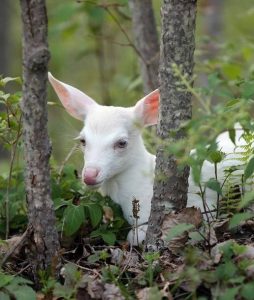
Hidden Treasures: The Life and Perils of a New White Fawn

White fawn in the woods. Photo credit: Tom Dorsey
Some of Leland’s white deer have been around for years (the oldest one lived to be 13!). Others grace the landscape for a short while and then are gone–the victims of cars, coyotes, or disease. Whatever the cause, it’s always a loss. It is spring that brings new life and, hopefully, new white fawns.
Fawning time in southern Wisconsin is typically from mid-May to early June, but Amy Sprecher, who has watched a family group of white deer near Leland for over a decade, says that most fawns in the area are born around May 15.
According to Amy, just before the new fawns are born, the does start chasing off the previous year’s fawns. Mom uses her hooves to get the point across (literally) and the young deer finally slink off—bruised and bewildered.
Now alone, the mom gives birth to one to three fawns. Twins are typical, but does occasionally have triplets. A severe winter may cause fetuses to abort, which happened in 2012 after record snow fell. Almost all the deer that spring produced only single fawns.
Most twins and triplets are fraternal, meaning fertilized from different eggs. If both fawns are brown, any variation is hard to tell, but if one fawn is white and one is brown, you’re definitely dealing with different genes.
Actually, with white or albino genes in the gene pool, you just never know what color the fawns are going to be—and that’s the exciting part. White moms can have brown kids, brown moms can have white kids, and sometimes the fawns are a mix. It’s a visual lesson in genetics.
White and albino genes are recessive, so a fawn needs to get one white gene from each parent to have the white coat color. It’s still pretty hard to speculate who the dad might be. A white buck is the obvious candidate, but brown bucks can also carry the white gene (as can brown moms).
To further complicate things, fawns from the same doe can have mixed paternity (aka the “mailman syndrome”). Research shows that about 25 percent of all sets of twins come from different fathers. There’s even a documented case of triplets being fathered by three different bucks.
Once the fawns are born, mom keeps the newborns hidden in the woods, tall grass, or field edges while she forages. Twins and triplets are normally stashed in separate locations. The mother only returns a few times a day to nurse so her presence and scent won’t tip off predators.
Although a doe spends little time with her fawns, she is usually no more than 100 yards away. Interestingly, the spot where a fawn is born will eventually become its home area.
Fawns are notoriously hard to find–even white ones. Photographer Mike Richard, who has white deer on his property and has taken some outstanding white fawn photos, uses a different tactic to get his shots. He lets the doe bring the fawns to him.
Mike knows the moms really well and where to find them. He gets up very early in the morning and waits out of sight with his camera. When the doe arrives, she gives a soft bleat and the fawn (photo subject in this case) stands up and heads over to mom. Voila, mom and fawn are ready for pictures!
Being a fawn of any color is all about survival. A very young fawn’s reaction to danger is to lay low with its head down until the danger passes. This instinctive behavior has worked well for thousands of years, but unfortunately has cost the lives of many fawns in the path of farm machinery.
Sometimes the danger to a fawn is not a predator but a well-meaning human attempting to “rescue” the presumed orphan. Fawns are rarely ever abandoned. The best thing to do if you find a fawn is to leave it alone, back away, and leave….quickly! Mom will return.
The science is mixed about how much human scent can affect a fawn or guide in a predator. Wildlife biologists who study and release fawns say most fawns do survive. As a general rule though, touching a fawn or getting too close is not a good idea.
If you happen to find a white fawn, consider yourself extremely lucky. White deer are already very rare, so finding a white fawn is really getting into the statistical stratosphere.
Fawns themselves have very little scent at this time. Hikers who accidentally find fawns often note that their dogs seem unaware of the young deer. It appears wild predators probably stumble upon fawns by accident.
Coyotes remain the biggest predators of fawns, especially in southern Wisconsin. In the north, bears and bobcats also kill a surprising number of fawns. Amy thinks more bobcats are now taking fawns locally, especially after seeing a white fawn with claw marks on its hindquarters—a sure sign of bobcat.
Just as brutal are the “mechanical predators.” Cars continue to kill deer of all ages, including many fawns. In farming areas where does frequently bed fawns in hay fields, mowers can also be a major cause of death.
Amy recounts how two white fawns were killed by a mower about three years ago and the mother kept pacing beside the field looking for her fawns. Losing those two white fawns was a huge loss—both for the mother and the community.
Although most fawn deaths are attributed to predators, there are large numbers of fawn losses even in areas without predators. Predators may just be taking fawns that are already dying of starvation or other natural causes (or, as one source put it, “eating the doomed”).
Fawn survival in general ranges from 33-68%, with fawns in the southern part of the state having the best odds. The first week or two seems to be critical for a fawn. If they are still alive after 7-10 days, the fawn has a good chance of surviving to adulthood.
There doesn’t seem to be any difference in survival between white and brown fawns. Last year, Amy observed two sets of twins, each consisting of a white fawn and a brown fawn. One white fawn survived from one set; one brown fawn from the other set.
Interestingly, it may be getting tougher for fawns to survive in the area. Amy remembers keeping track of seven white does in 2013. They all had twins (14 total–half white and half brown), and all the fawns survived.
In 2018, out of six fawns of different colors, only one survived—and it wasn’t a brown fawn; it was a white one. The popular belief that white deer are more easily seen and killed by predators doesn’t appear to be the case.
By the time a fawn is 3-4 weeks old, it will be able to run fast enough to elude a predator and keep up with mom. The fawns will also start browsing young saplings and choosing their own bedding sites.
At this time, too, the rejected older siblings will be allowed to rejoin the group. Amy says this is pretty variable though—sometimes the doe lets the yearlings come back fairly soon after the new fawns are born and sometimes not.
Like a jealous sibling, though, the yearlings can pick on the new fawns (now they are the ones doing the “hoofing”), so it isn’t always a friendly reunion.
Life ahead can still be pretty tough for the growing fawns, especially if it involves crossing a road. Cars and trucks have caused the death of more than a few white deer in the area. Unfortunately, deer didn’t evolve around speeding cars, and headlights are an absolute killer.
Any number of diseases have also taken a toll on all the area deer, including CWD (Chronic Wasting Disease) and EHD (Epizoatic Hemorrhagic Disease), which is spread by midges and hit Sauk Couny especially hard last year.
Sad to say, occasional white deer—the ones with a little bit of brown—are still being shot. This is especially tragic for all the people who have enjoyed watching that deer, and for the loss of the deer’s potential offspring.
If luck holds, though, the white fawns will survive all the hazards that nature and man can throw at them and become new members of a very unique group–the white deer that are so loved and treasured in the Leland area.

